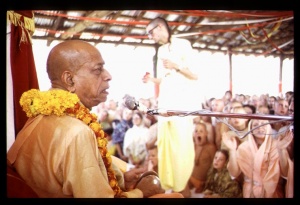CC Adi 3.18 (1975): Difference between revisions
(Vanibot #0027: CCMirror - Mirror CC's 1996 edition to form a basis for 1975) |
(Vanibot #0020: VersionCompareLinker - added a link to the Version Compare feature) |
||
| Line 2: | Line 2: | ||
<div style="float:left">'''[[Sri Caitanya-caritamrta (1975)|Śrī Caitanya-caritāmṛta (1975)]] - [[CC Adi (1975)|Ādi-līlā]] - [[CC Adi 3 (1975)|Chapter 3: The External Reasons for the Appearance of Śrī Caitanya Mahāprabhu]]'''</div> | <div style="float:left">'''[[Sri Caitanya-caritamrta (1975)|Śrī Caitanya-caritāmṛta (1975)]] - [[CC Adi (1975)|Ādi-līlā]] - [[CC Adi 3 (1975)|Chapter 3: The External Reasons for the Appearance of Śrī Caitanya Mahāprabhu]]'''</div> | ||
<div style="float:right">[[File:Go-previous.png|link=CC Adi 3.17 (1975)|Ādi-līlā 3.17]] '''[[CC Adi 3.17 (1975)|Ādi-līlā 3.17]] - [[CC Adi 3.19 (1975)|Ādi-līlā 3.19]]''' [[File:Go-next.png|link=CC Adi 3.19 (1975)|Ādi-līlā 3.19]]</div> | <div style="float:right">[[File:Go-previous.png|link=CC Adi 3.17 (1975)|Ādi-līlā 3.17]] '''[[CC Adi 3.17 (1975)|Ādi-līlā 3.17]] - [[CC Adi 3.19 (1975)|Ādi-līlā 3.19]]''' [[File:Go-next.png|link=CC Adi 3.19 (1975)|Ādi-līlā 3.19]]</div> | ||
{{CompareVersions|CC|Adi 3.18|CC 1975|CC 1996}} | |||
{{RandomImage}} | {{RandomImage}} | ||
==== TEXT 18 ==== | ==== TEXT 18 ==== | ||
<div class="verse"> | <div class="verse"> | ||
: | :"By performing such regulated devotional service in awe and veneration, one may go to Vaikuṇṭha and attain the four kinds of liberation. | ||
</div> | </div> | ||
| Line 18: | Line 16: | ||
<div class="synonyms"> | <div class="synonyms"> | ||
sārṣṭi—opulences equal | sārṣṭi—opulences equal with the Lord's; sārūpya—the same form as the Lord's; āra—and; sāmīpya—personal association with the Lord; sālokya—residence on a Vaikuṇṭha planet; sāyujya—oneness with the Lord; nā laya—they do not accept; bhakta—devotees; yāte—since; brahma-aikya—oneness with Brahman. | ||
</div> | </div> | ||
| Line 25: | Line 23: | ||
<div class="translation"> | <div class="translation"> | ||
"These liberations are sārṣṭi [achieving opulences equal to those of the Lord], sārūpya [having a form the same as the Lord's], sāmīpya [living as a personal associate of the Lord] and sālokya [living on a Vaikuṇṭha planet]. Devotees never accept sāyujya, however, since that is oneness with Brahman. | |||
</div> | </div> | ||
Latest revision as of 17:14, 26 January 2020

A.C. Bhaktivedanta Swami Prabhupada
TEXT 18
- "By performing such regulated devotional service in awe and veneration, one may go to Vaikuṇṭha and attain the four kinds of liberation.
SYNONYMS
sārṣṭi—opulences equal with the Lord's; sārūpya—the same form as the Lord's; āra—and; sāmīpya—personal association with the Lord; sālokya—residence on a Vaikuṇṭha planet; sāyujya—oneness with the Lord; nā laya—they do not accept; bhakta—devotees; yāte—since; brahma-aikya—oneness with Brahman.
TRANSLATION
"These liberations are sārṣṭi [achieving opulences equal to those of the Lord], sārūpya [having a form the same as the Lord's], sāmīpya [living as a personal associate of the Lord] and sālokya [living on a Vaikuṇṭha planet]. Devotees never accept sāyujya, however, since that is oneness with Brahman.
PURPORT
Those engaged in devotional service according to the ritualistic principles mentioned in the scriptures attain these different kinds of liberation. But although such devotees can attain sārṣṭi, sārūpya, sāmīpya and sālokya, they are not concerned with these liberations, for such devotees are satisfied only in rendering transcendental loving service to the Lord. The fifth kind of liberation, sāyujya, is never accepted even by devotees who perform only ritualistic worship. To attain sāyujya, or merging into the Brahman effulgence of the Supreme Personality of Godhead, is the aspiration of the impersonalists. A devotee never cares for sāyujya liberation.